The Google Search Console (GSC) “Links” report is a particularly useful part of GSC.
We'll explain how you can use it to understand your digital footprint and build more backlinks.
What Is the Google Search Console Links Report?
“Links” is a report within Google Search Console (GSC) that shows how other sites link to your site and how your site links internally.
Tracking external links, or backlinks, and internal links is important. It lets you see sites that link to you the most, your most influential pages, and more. All of which provide an in-depth view of your online presence.
The GSC “Links” report offers several data points, including:
- Top linked pages: pages on your site that get the most backlinks
- Top linking sites: external sites that link to you the most
- Top linking text: the most common anchor text used in links to your site
- Top internally linked pages: pages on your site with the most internal links
Why Is the Links Report Important for SEO?
The “Links” report is a useful tool to understand and improve your SEO performance.
The report provides insights into backlinks, a confirmed SEO ranking factor. Google views links from reputable sites that point to your site as a vote of confidence.
In other words, proof that your site is high-quality and worthy of even more organic visits.
Knowing which sites link to you and which pages attract the most backlinks can inform your SEO strategy. So you know what type of content to produce to attract even more backlinks.
Internal links are important, too. They enable both visitors and website crawlers to discover and navigate your site more easily.

Internal links also pass authority (or PageRank) to linked pages, helping them rank higher in search results.
How to Access the ‘Links’ Report
Accessing the “Links” report is a straightforward process.
First, navigate to GSC and log in.
Select the relevant property in the upper left box. Then, find and click “Links” at the bottom of the left-hand sidebar.
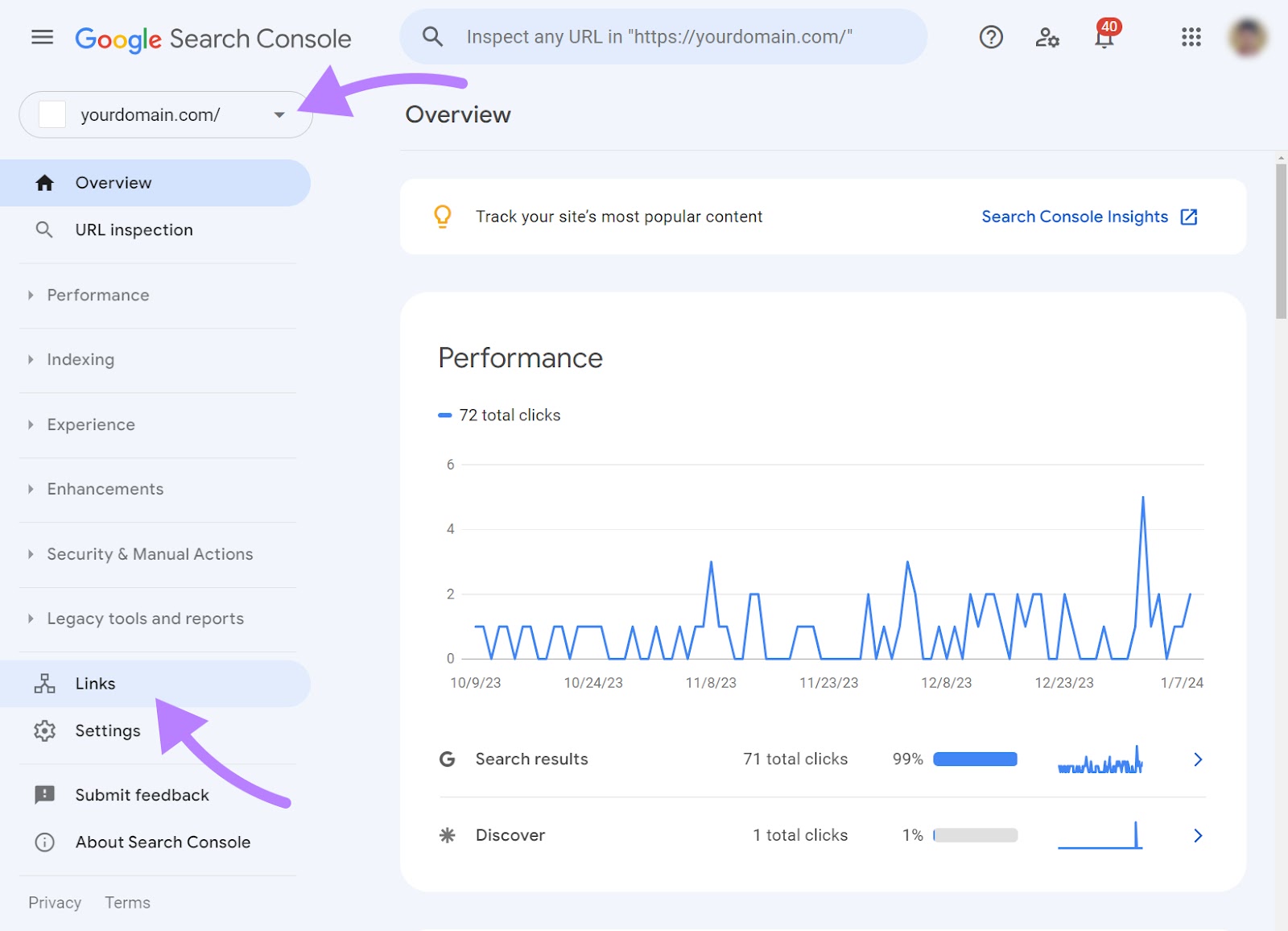
You’ll now reach the main “Links” dashboard.
The available link data is divided into “External links” and “Internal links” categories.
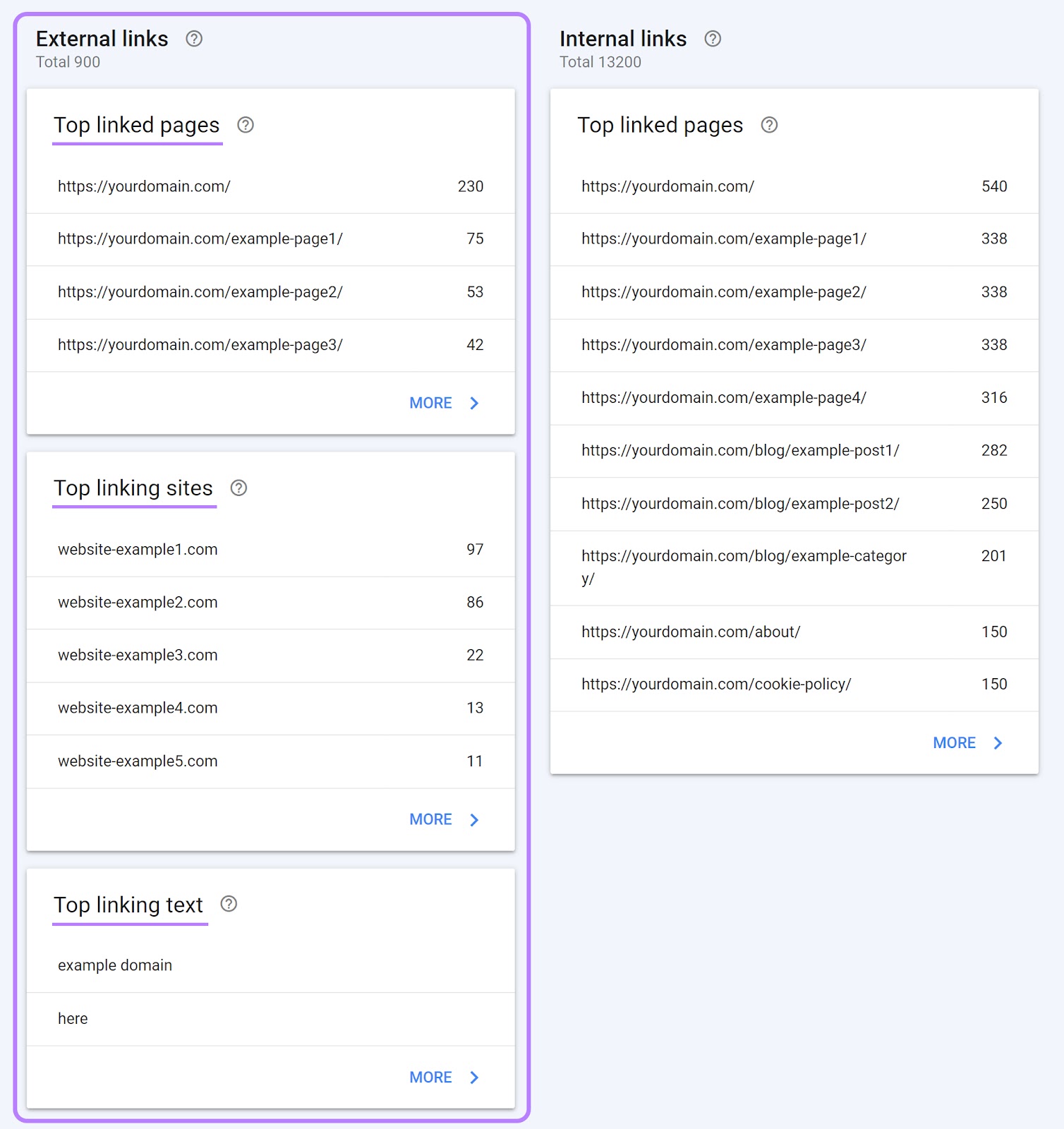
In the “External links” category, you can find top linked pages, top linking sites, and top linking text.
You can also find top linking sites for each of your pages. Just click on a specific linked page, and you’ll get a report similar to this:
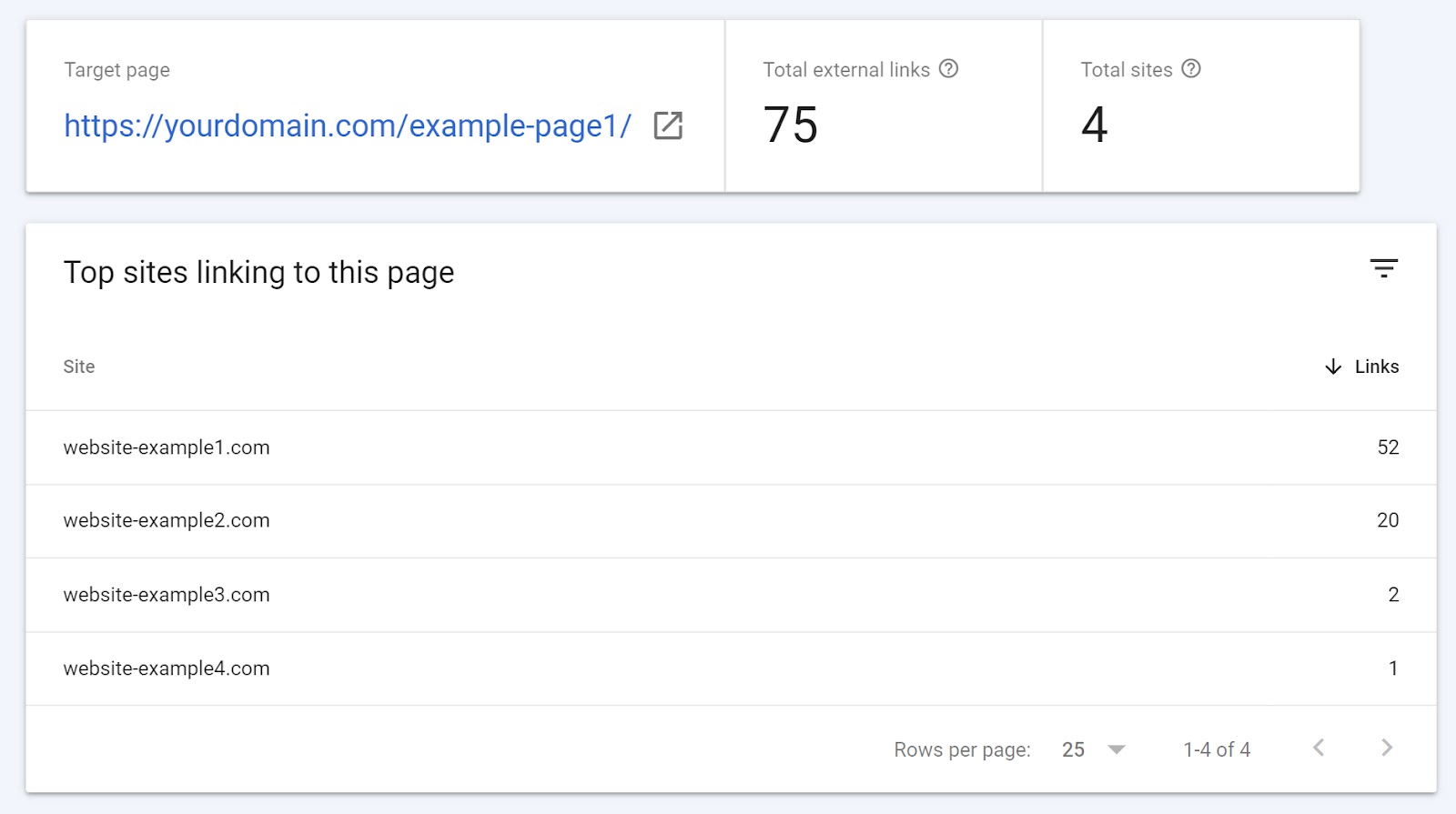
You can also see all the backlinks from a specific site. Simply click on a linking site in the main menu, and you’ll access a view similar to this one:
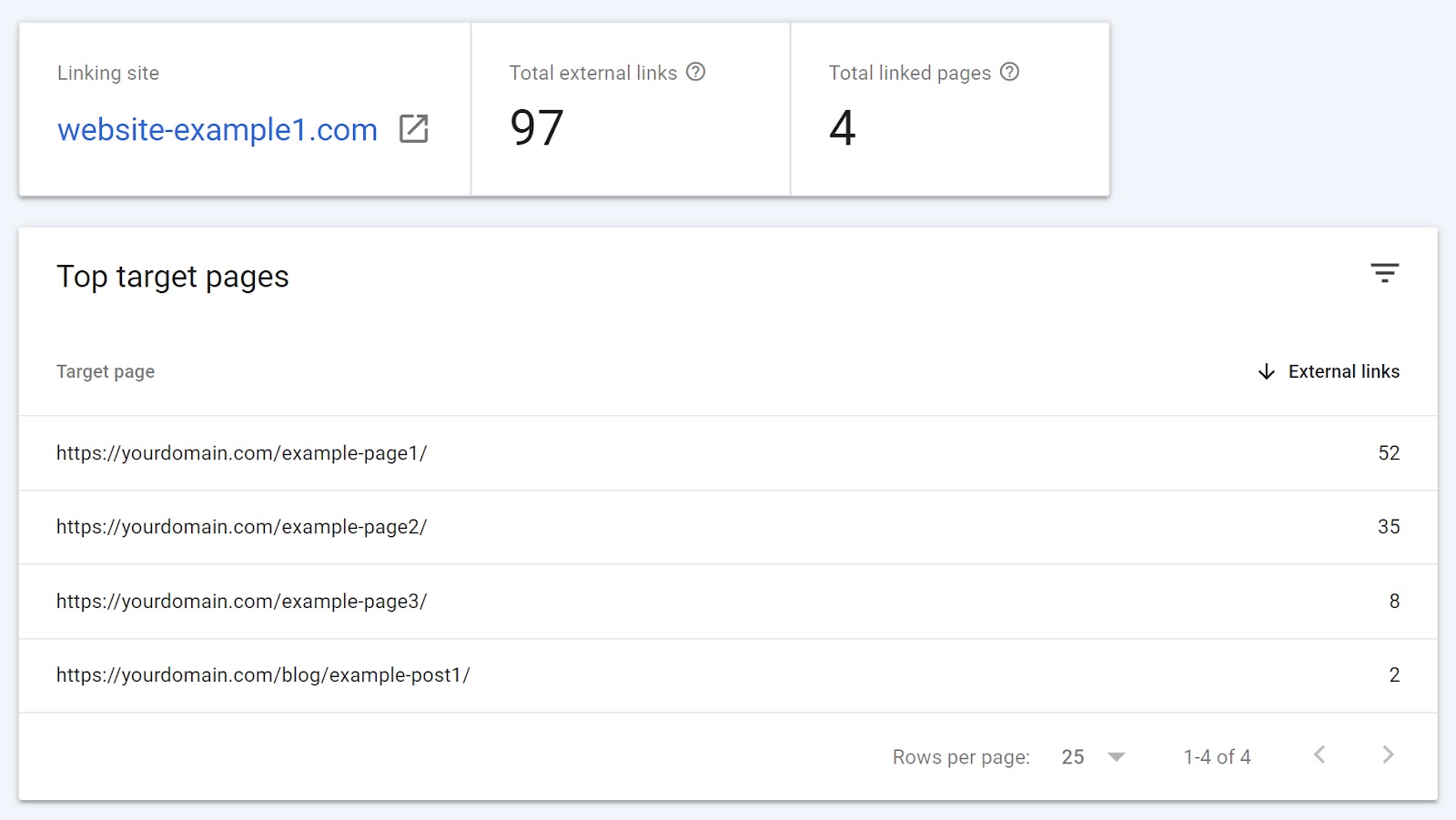
And if you click on a specific target page on this list, you can see all the backlinks it got from this linking site.
In the “Internal links” category, you can review the top internally linked pages. You can also click on each page to get the list of internal pages that link to it. Like here:
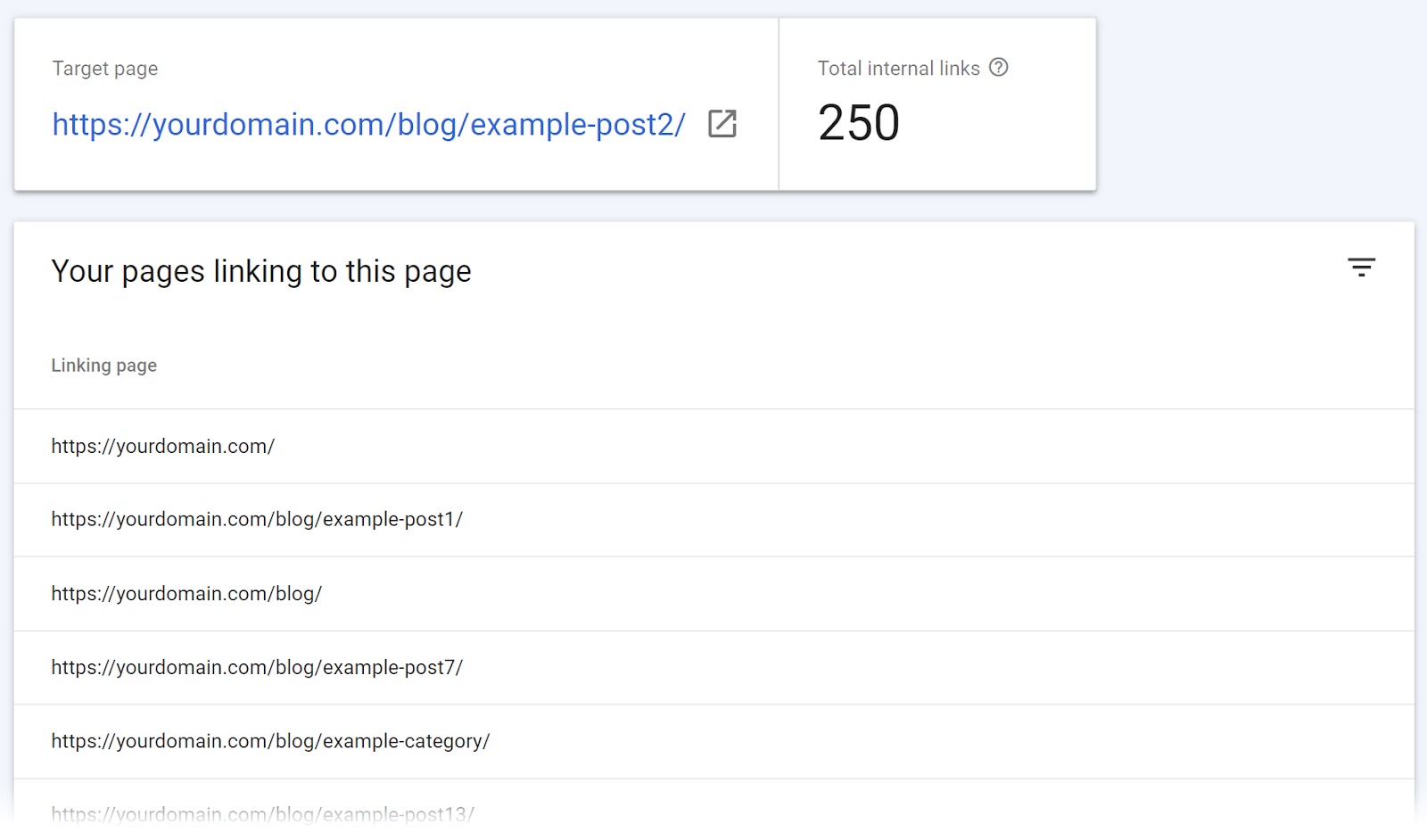
And you can extract both external and internal link data to analyze it in Excel or similar software.
To extract external links, click on "EXPORT EXTERNAL LINKS" in the upper right corner of the main “Links” dashboard, and select "Latest links."
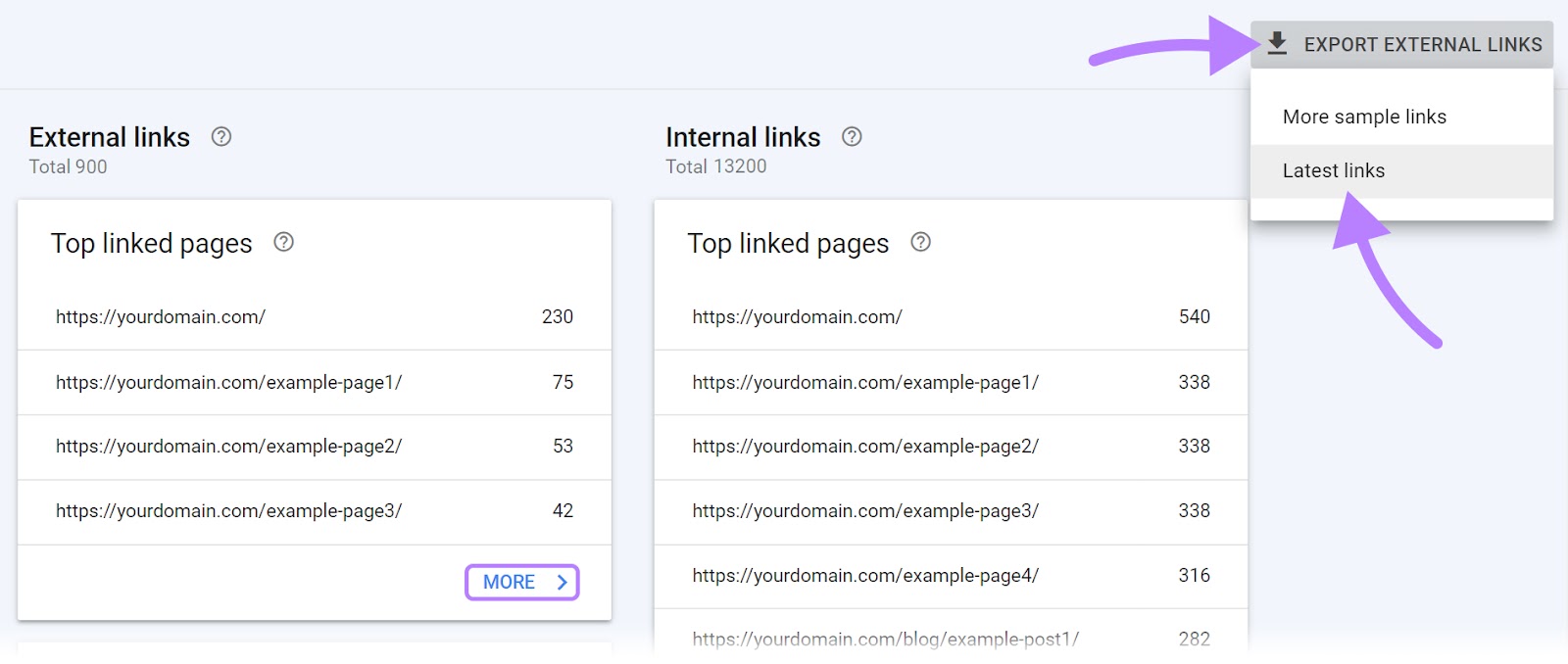
You can also extract more granular data. Simply click “MORE >” underneath each data point on the main dashboard.
Below is the report you get when you click “MORE >” to access the top internally linked pages data. Click “Export” in the upper right corner. You can then choose whether to download data in Google Sheets, Excel, or CSV format.
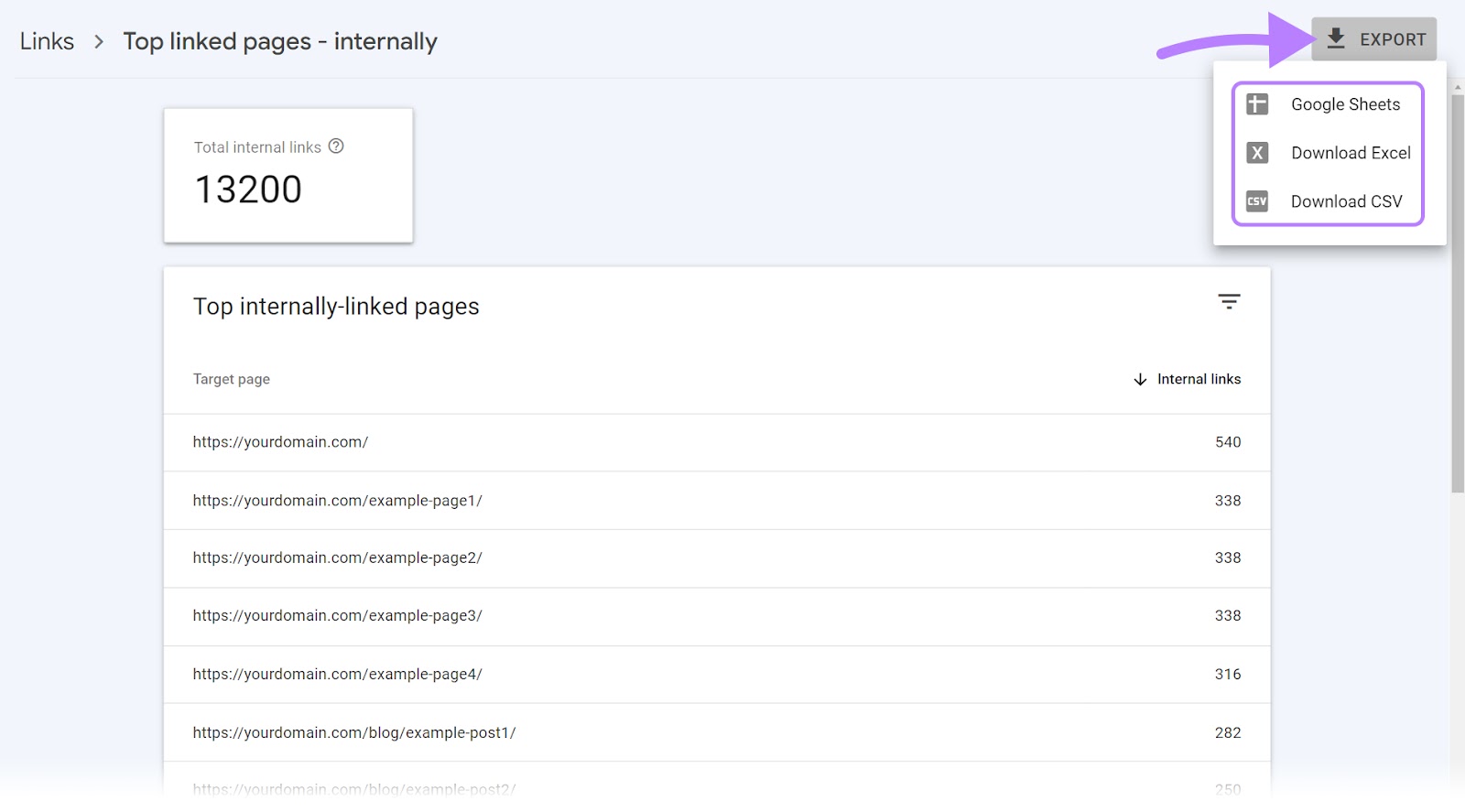
How to Interpret Link Data
The “Links” report offers a wealth of insights. Here are some guidelines on how to interpret its data.
Top Linked Pages
A high number of backlinks to your pages can signal their popularity and relevance. You want to ensure that you drive backlinks to important pages, like a homepage, product pages, blog posts, or data reports.
Conversely, a low number of backlinks can mean your site lacks link-worthy content or pages.
Top Linking Sites
Getting backlinks from reputable sites is beneficial for SEO. Ideally, many of those sites would be relevant to your niche.
For instance, a healthcare business would greatly benefit from receiving a backlink from WebMD, an authoritative source of medical news.
But links from low-quality or spammy sites are unlikely to improve your site’s ranking.
Top Linking Text
The anchor text gives context to search engines about the content of the linked page. Ideally, the anchor text used in your backlinks should be relevant and varied.
Search engines might see over-optimized anchor text (like using exact-match keywords excessively) as manipulative.
Top Internally Linked Pages
Your internal links should connect many of your pages. But you should especially focus on adding internal links to strategic and revenue-generating pages.
For instance, a B2B SaaS startup might push internal links (and thus their authority or PageRank) to product landing pages to ensure these pages show up in search results and attract prospects.
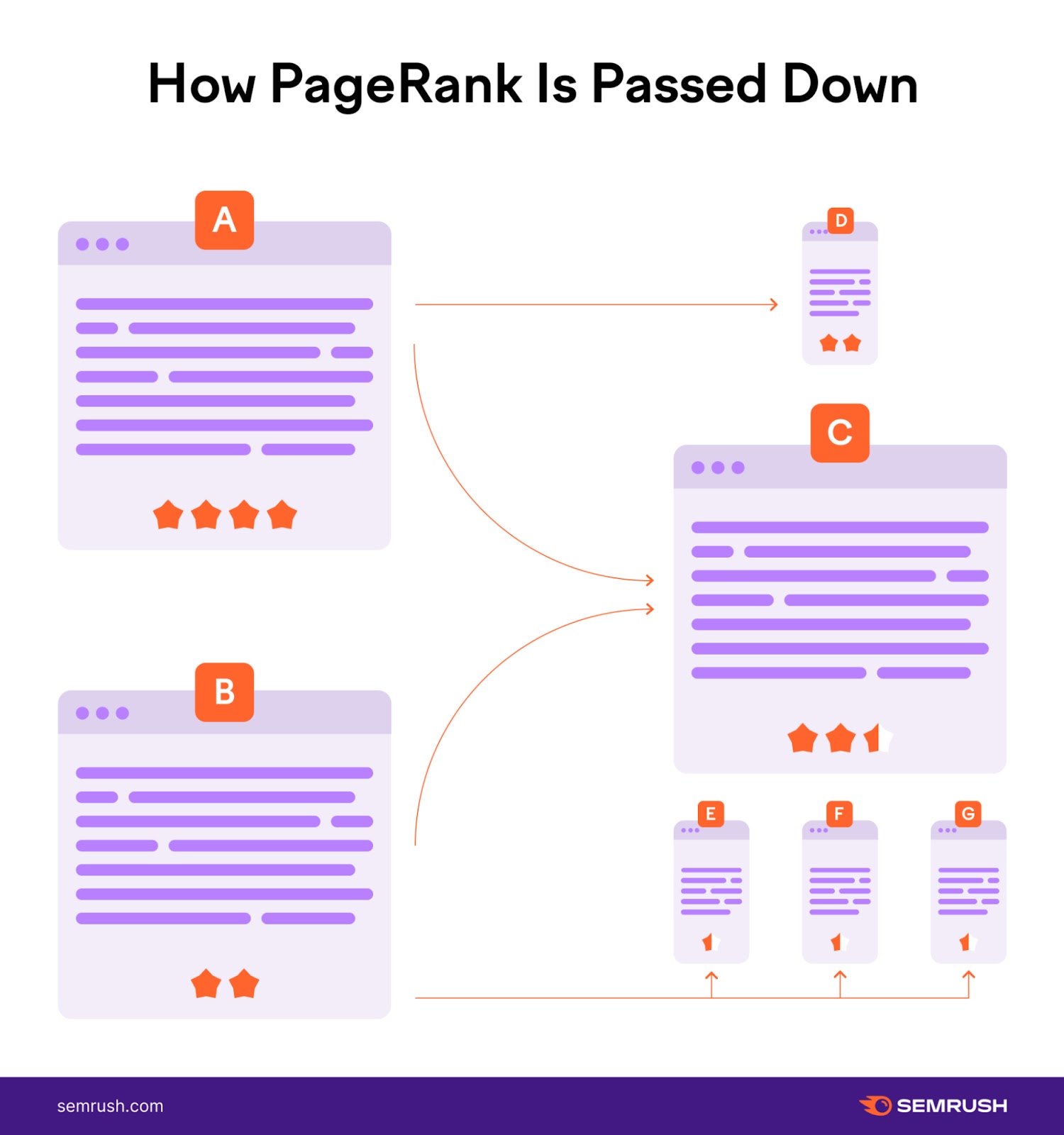
How to Analyze Your Backlink Profile to Improve SEO
Your backlink profile is the collection of all backlinks that point to your site.
Backlinks from legacy media, big companies, universities, and other trustworthy sites can elevate your backlink profile and SEO performance.
For instance, here’s the major software company HubSpot linking to one of Semrush's courses in a blog post.

Getting these sorts of quality backlinks is vital for building and maintaining strong SEO performance.
But links from spammy sites, known as bad or toxic backlinks, won’t be of benefit, and can in fact be detrimental.
Toxic backlinks may also be generated by paying for links, exchanging links, using link-building bots, and other practices.
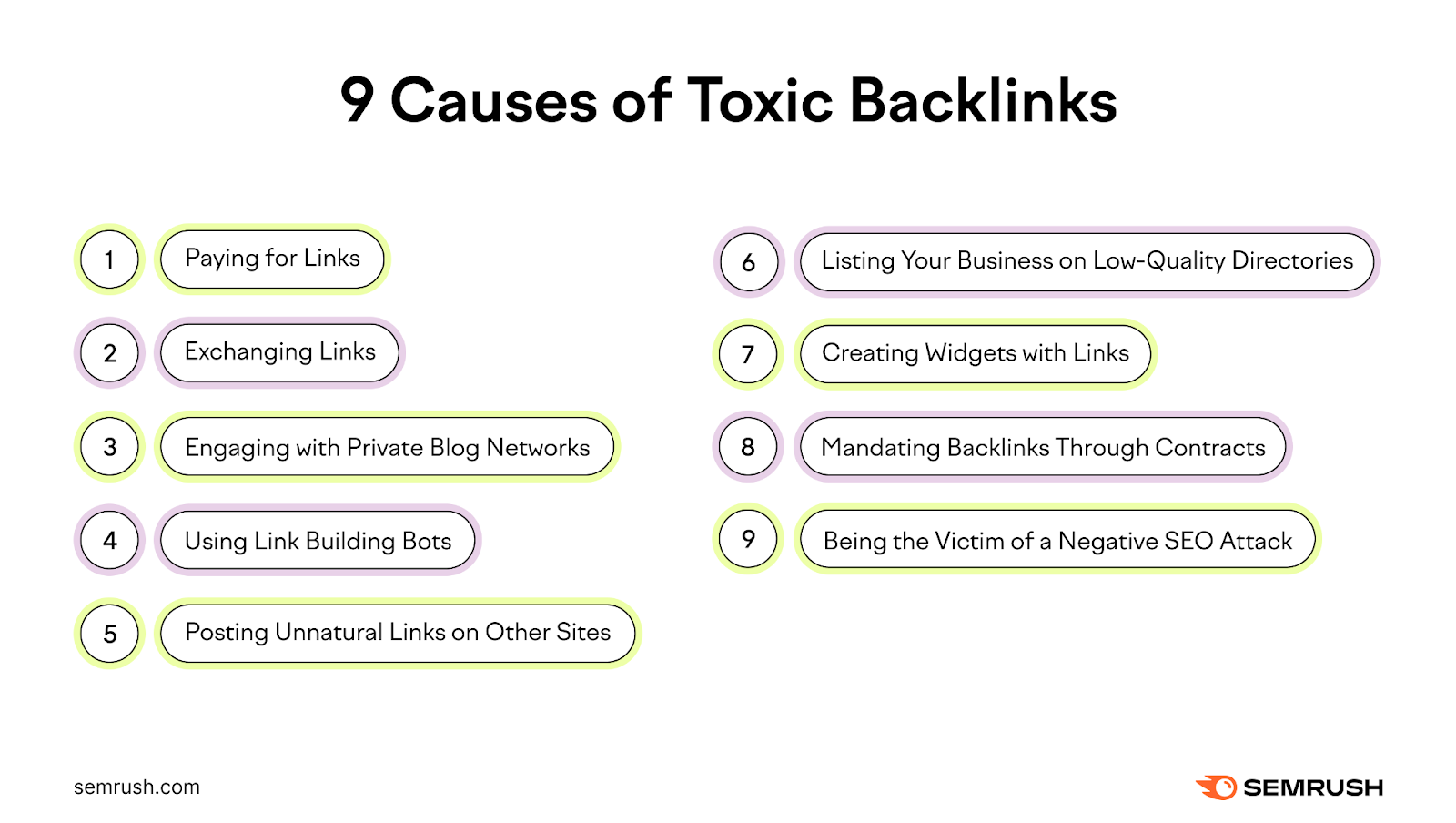
Bad backlinks could hurt your search rankings. Because Google wants to discourage manipulative link building.
If Google thinks you engaged in link spam tactics, you could receive a manual action, known as Google penalty. This can suppress your site or remove it from search rankings altogether.
Sign into your GSC account to check if you have a manual action.
Go to “Security & Manual Actions” > “Manual actions.”
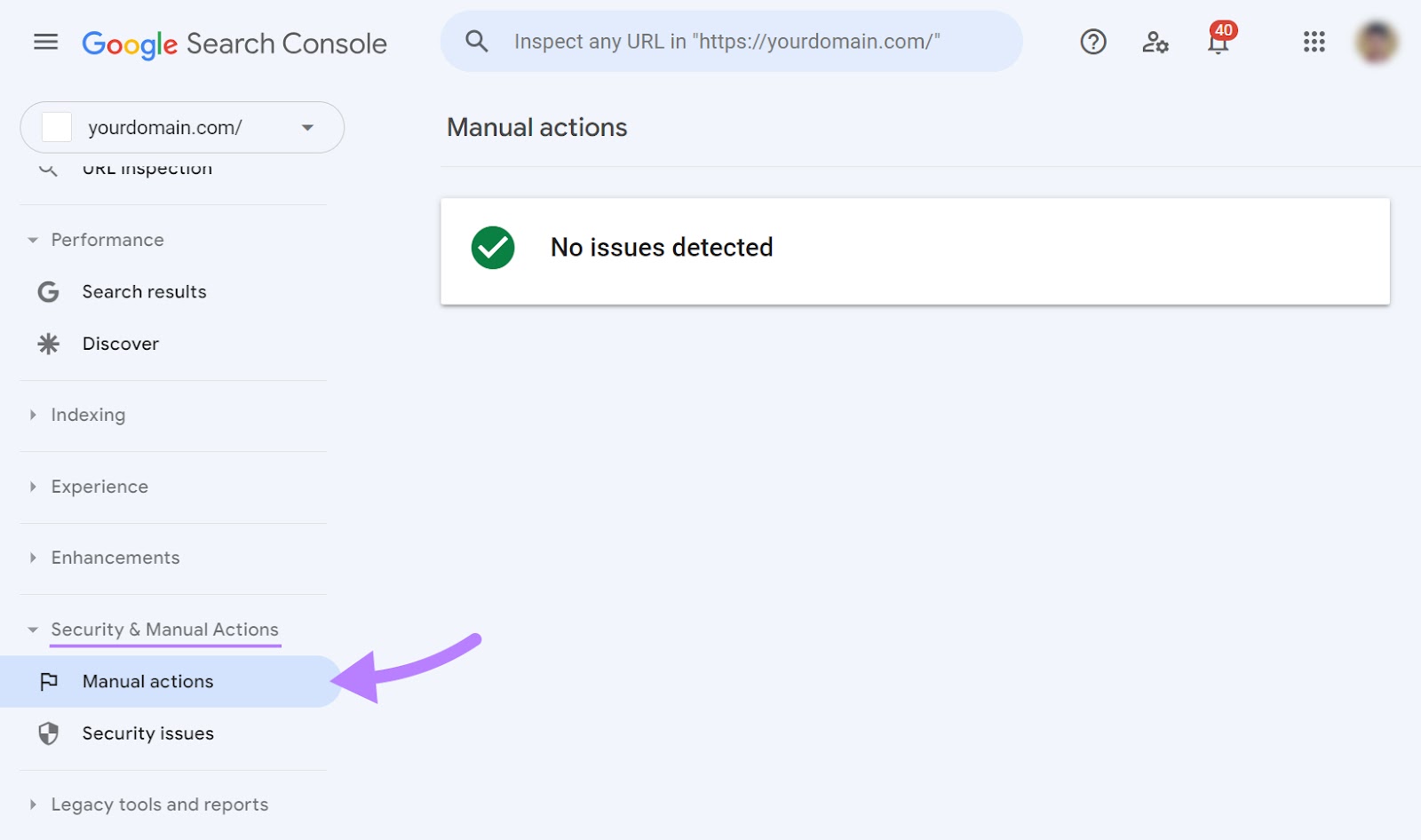
Google is good at ignoring spammy backlinks your site may randomly attract over time.
But if you're worried about your past link-building tactics, or you were hit with a manual penalty, you should check for toxic backlinks. And sort them out so your site can start recovering.
You can find harmful backlinks by using toxic backlinks checkers like Semrush’s Backlink Audit tool.
Head to this tool, enter your domain, and click “Start Backlink Audit.”

Then, go through four steps to set up backlink audit settings.
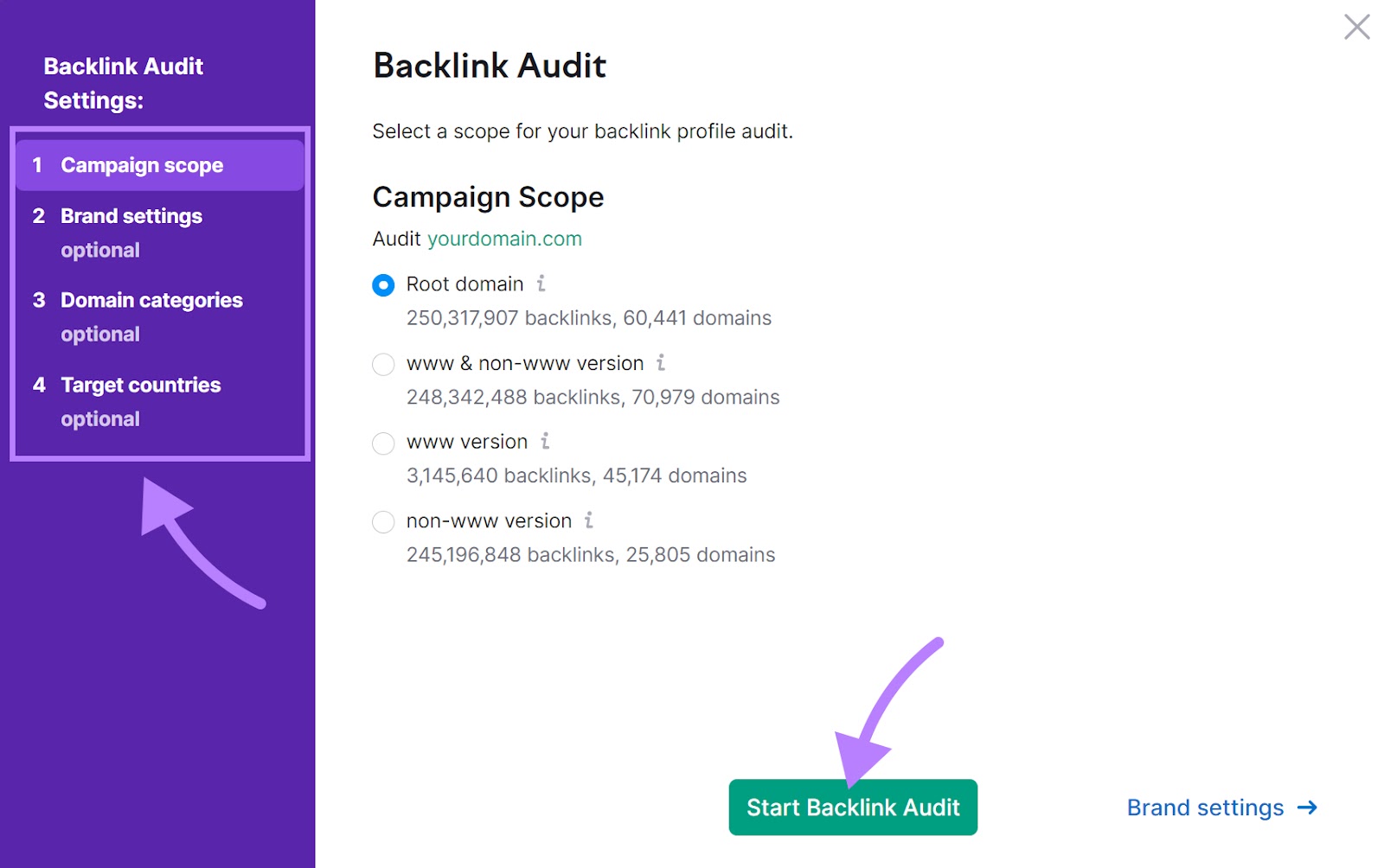
You typically want to do the audit of your root domain to ensure it covers all the URLs and subdomains.
After that, you’ll be asked to add your brand names, select relevant themes your domain is associated with, and specify target countries.
Click “Start Backlink Audit” after that.
Once the audit is completed, head to the main “Overview” report.
Click “Integrations” to connect Backlink Audit with Google Analytics 4, GSC, or Majestic.
Then, click “Connect” underneath each tool and you’ll view instructions on how to carry out specific integration. You’ll have to connect Semrush with the Google accounts you use to access GA4 and GSC. With Majestic, you’ll need to generate an access token and paste it into the provided box.

Connecting Backlink Audit with GSC enables Semrush to have up-to-date data on your backlinks.
You can now head to the “Audit” tab to review bad backlinks the tool has identified.
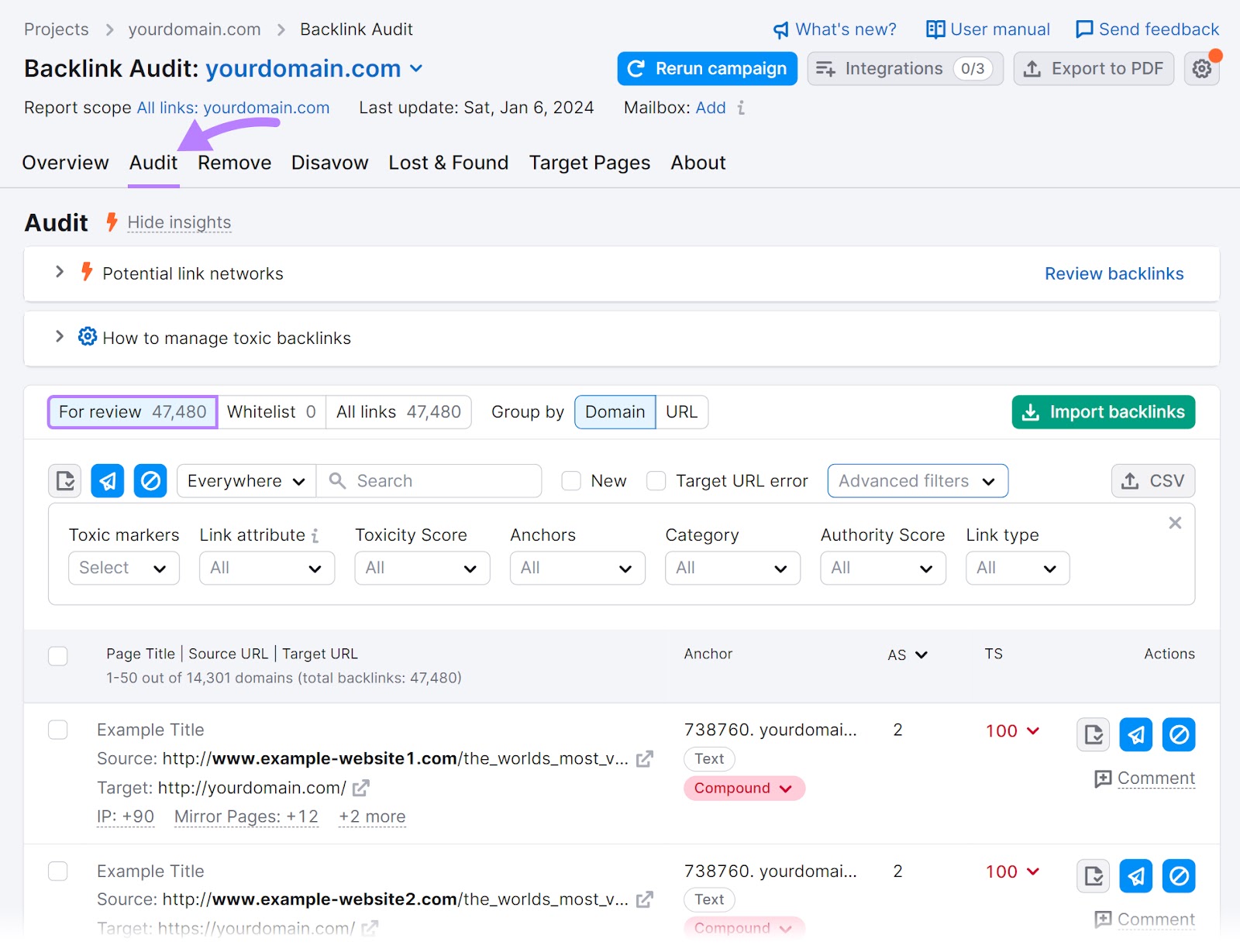
Each backlink is assigned a Toxicity Score (TS) from 0-100. Semrush uses over 45 toxicity markers to determine TS, and the higher the score, the higher the chance the link is toxic.
You can click on a TS to learn which toxicity markers were found.
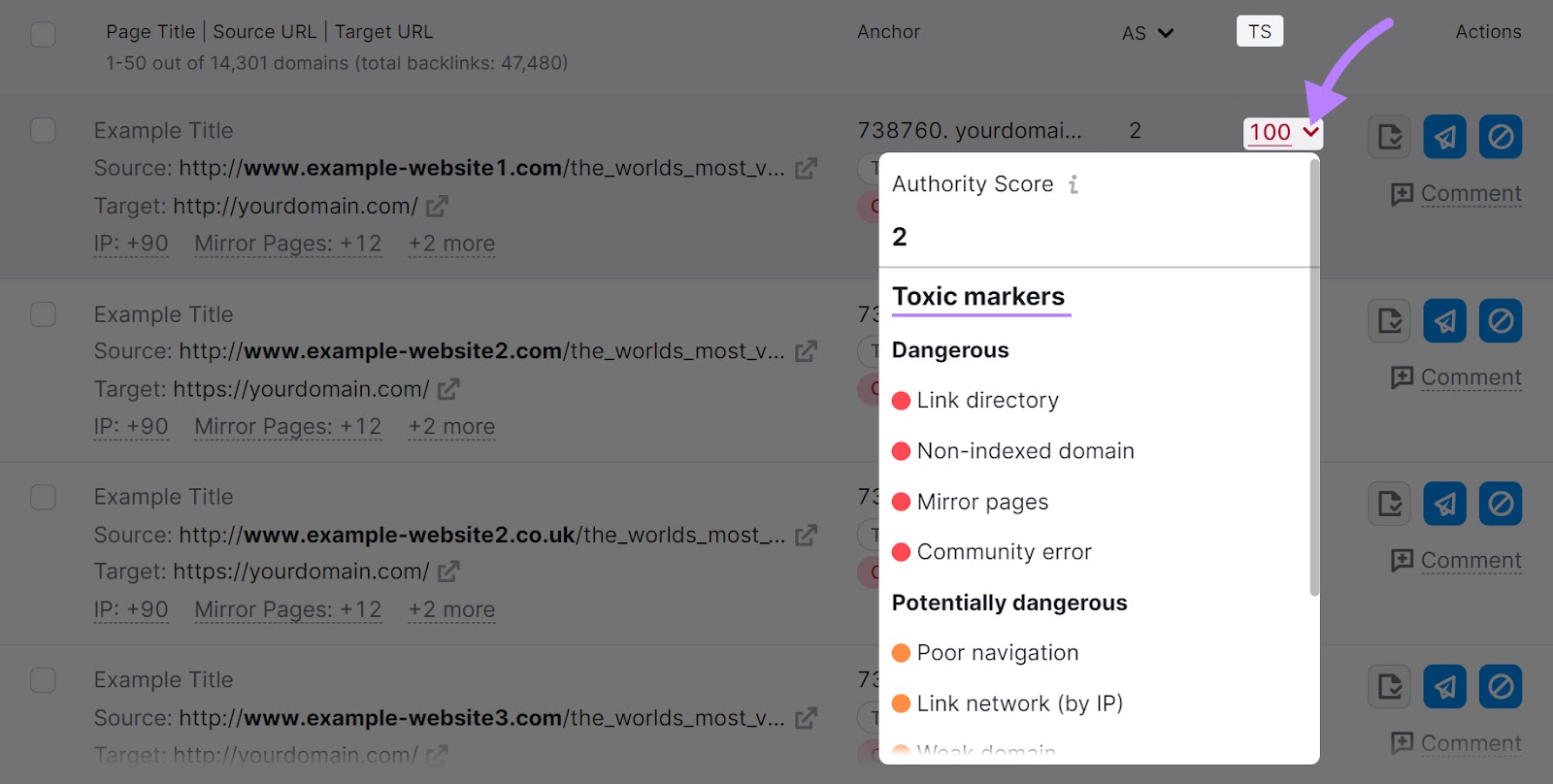
Next to TS is the Authority Score (AS) column. AS measures the page’s overall authority and SEO performance. A higher score indicates a more authoritative site that’s less likely to be a bad backlink.
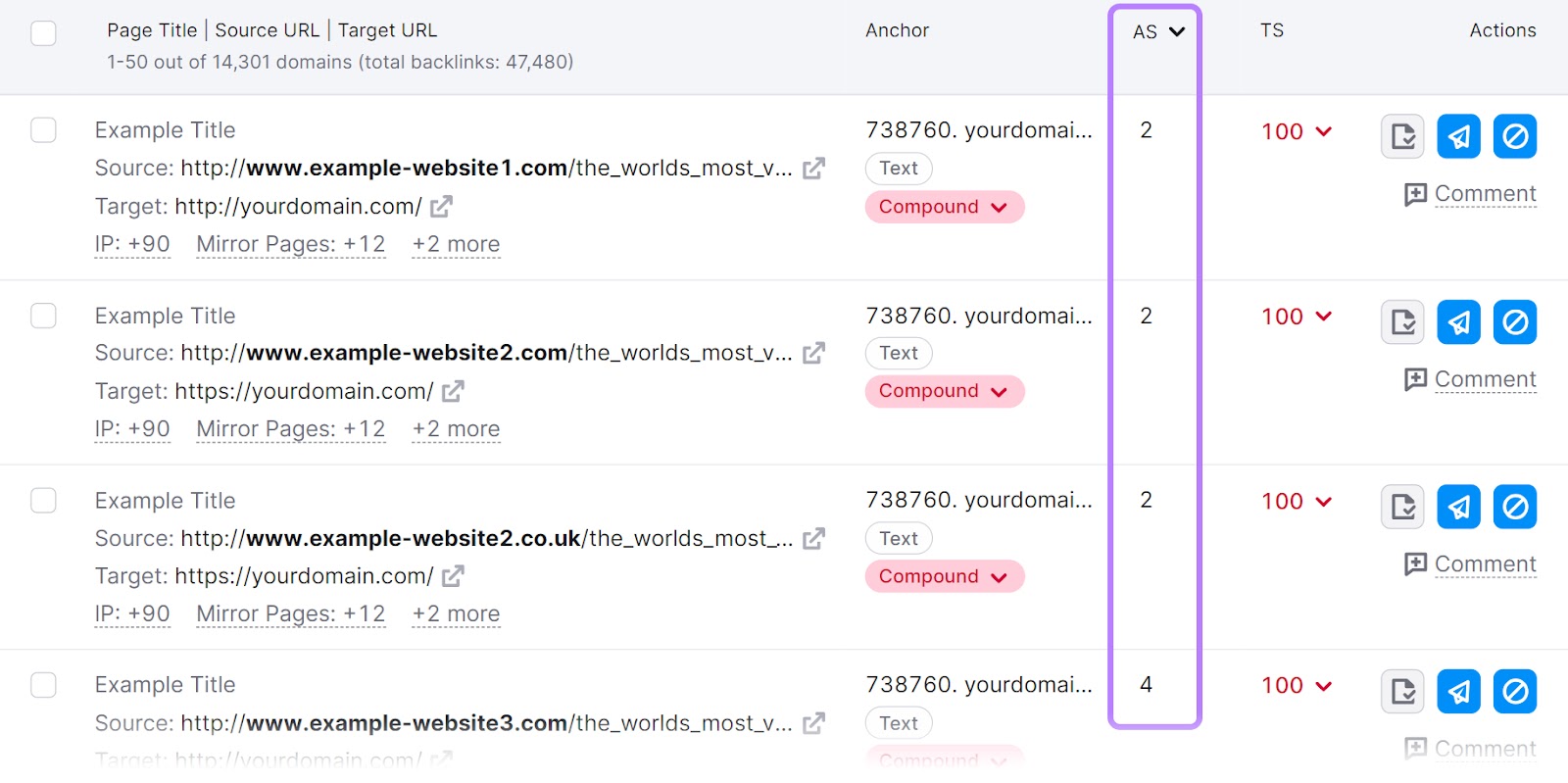
Lastly, you may also want to review the backlink’s anchor text. Bad backlinks tend to use one of two types of anchor text, both of which tend to be overly SEO-optimized:
- “Money” anchor text, which is very similar to the keywords the site is trying to rank for (e.g., “best sports watches”)
- “Compound” anchor text, which consists of a brand name and another phrase (e.g., “eBay sports jacket”)

You can now start reviewing backlinks using the information from the audit.
If you want to keep a backlink, click the “Move to Whitelist” icon.
If you want to remove a backlink by contacting a site owner, click the “Move to Remove list” icon.
If you want to go straight to disavowing a backlink through GSC, then click the “Move to Disavow list” icon.
(Disavowing links is asking Google to ignore specific links (and their SEO impact) to your site. This is an advanced SEO tactic that you should not do unless you are absolutely certain you know what you’re doing.)
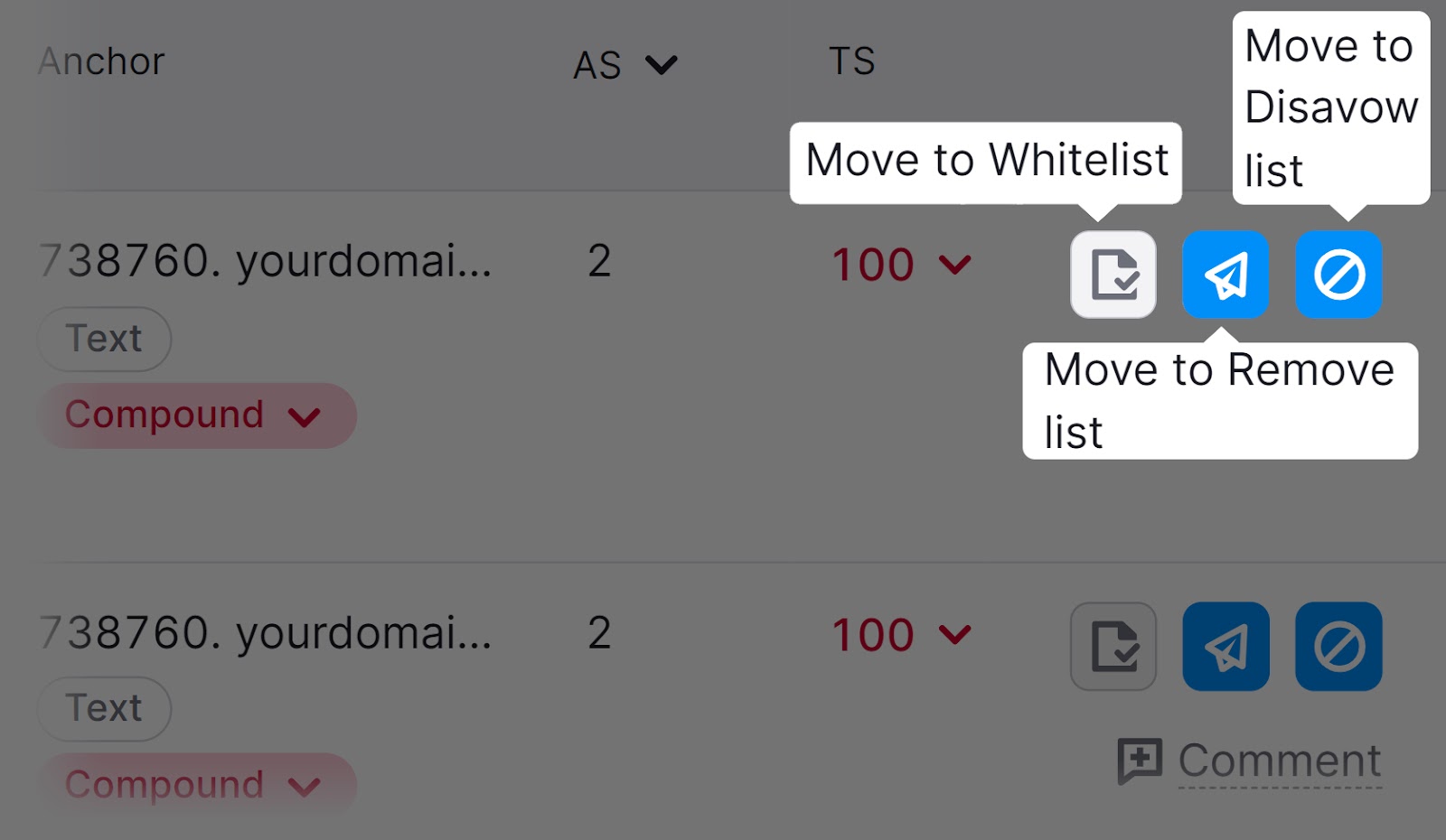
Go to the “Remove” tab to inspect all the backlinks marked for removal.
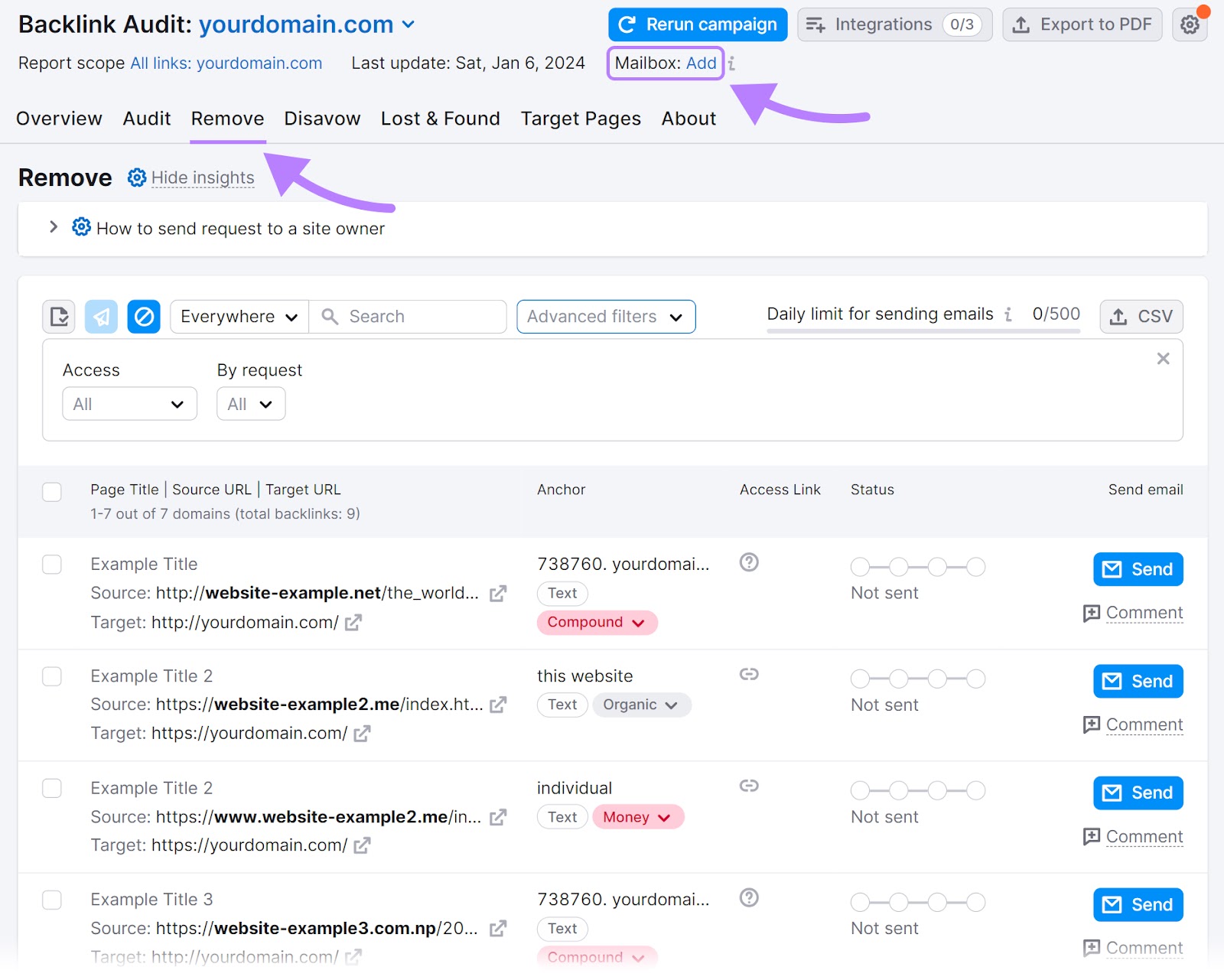
Click “Add” next to “Mailbox” at the top, then follow the instructions to connect your business mailbox with Semrush. You’ll then be able to send emails from within our tool.
Next, choose a backlink you want to tackle, and find its domain owner’s email address.
When ready, click “Send,” draft an email, and send it.

Our tool will update the “Status” column afterward to “Sent.” And it will also update this column when your email has been delivered, read, and replied to.
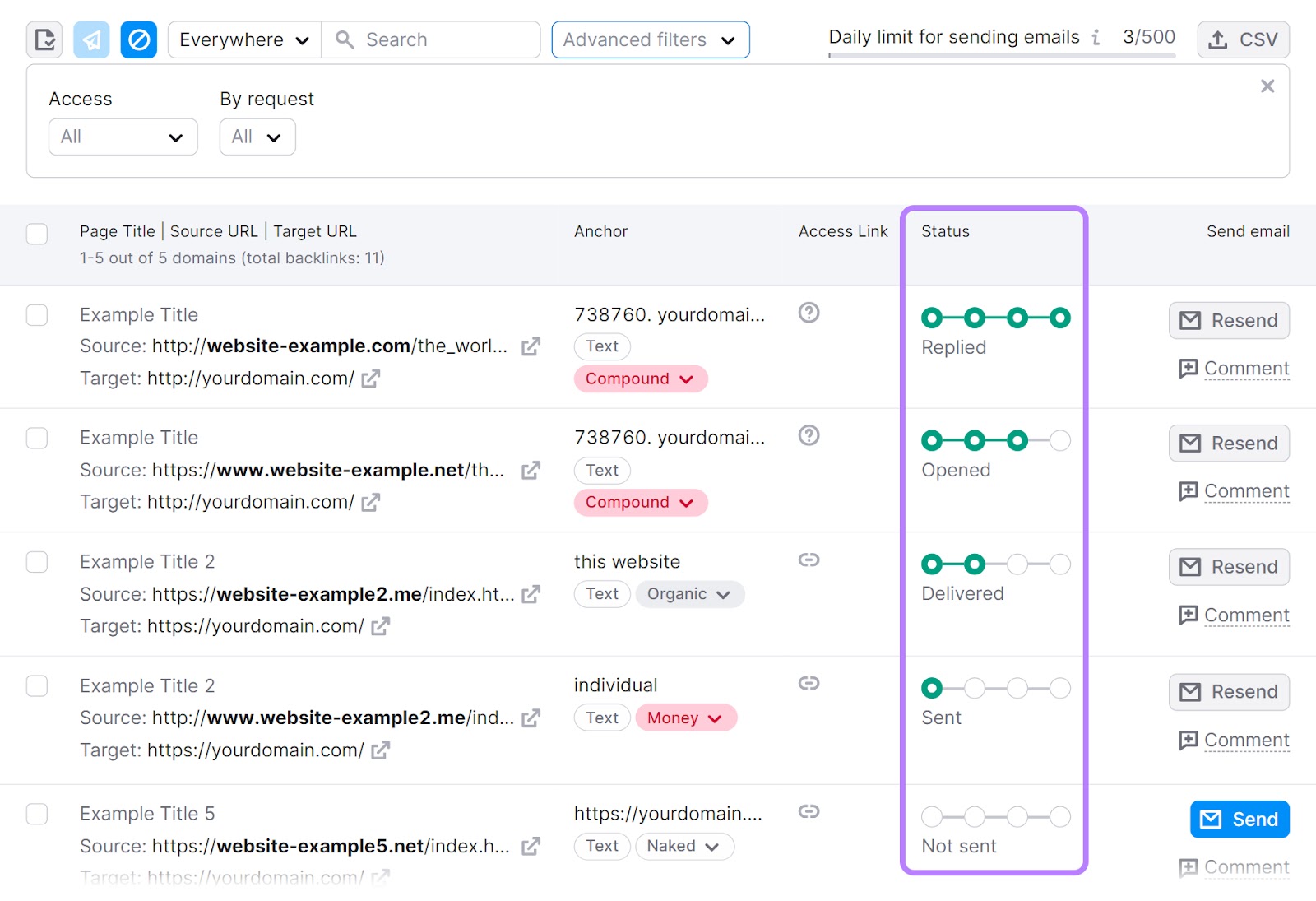
If these toxic backlinks aren’t removed after a few weeks, you can consider adding them to the “Disavow” list, as well.
You can do that by going back to the “Remove” list, selecting backlinks, and clicking “Disavow.”
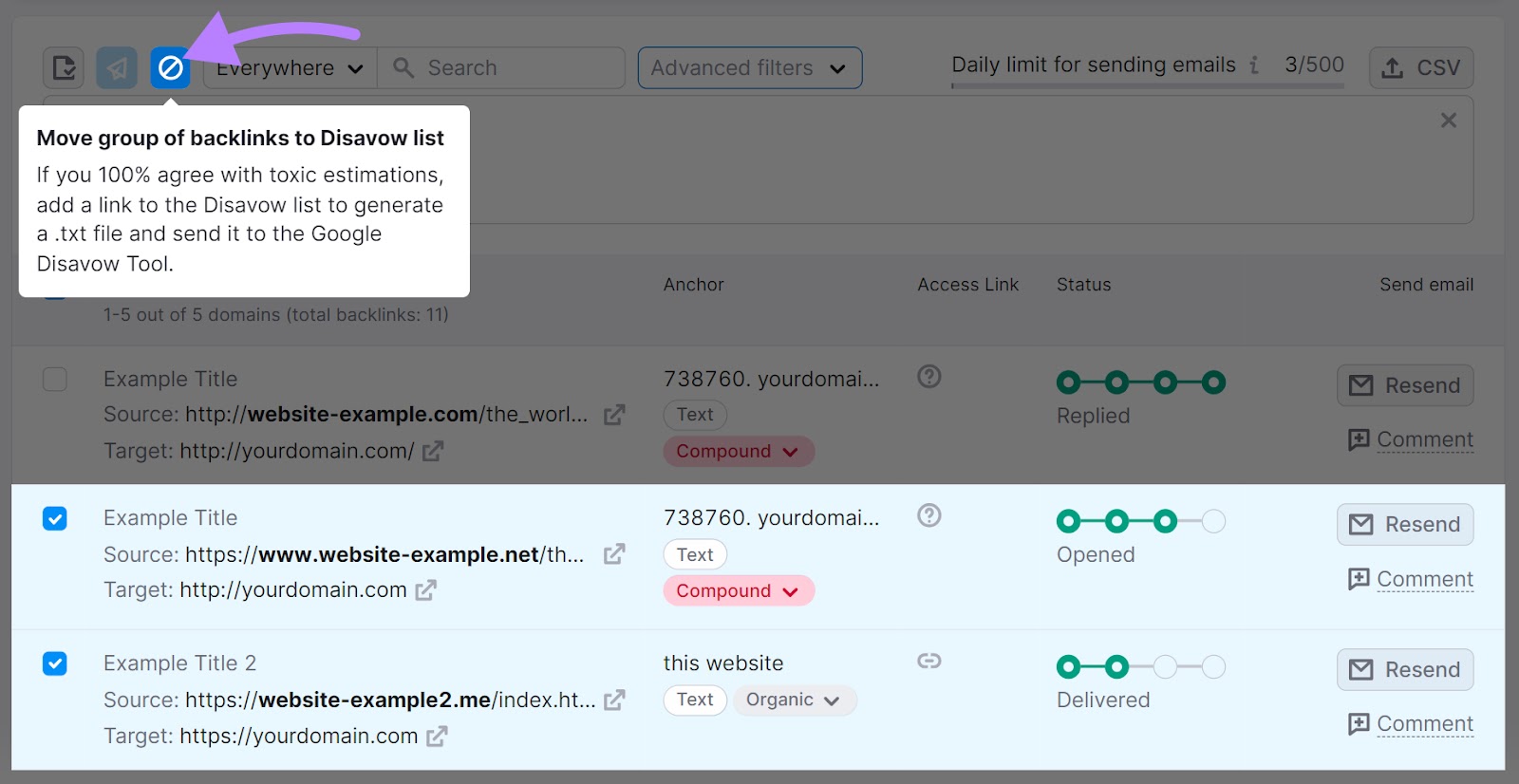
When moving backlinks to “Disavow,” consider disavowing at the domain level. So that you can disavow all pages that might link to you from that site, both now and in the future.
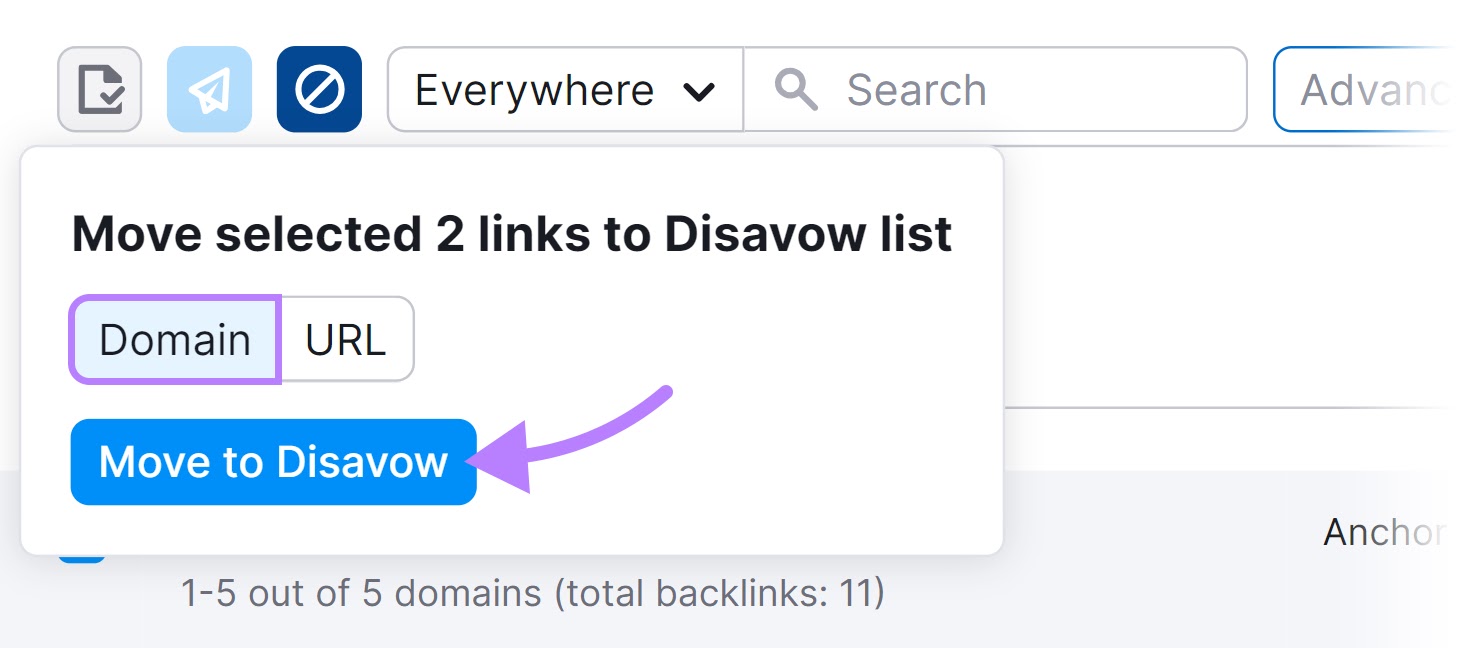
Disavowing links should only be done as a last measure. Google’s John Mueller (@JohnMu on X) advises to only disavow links if you know there’s an actual issue that disavowing will resolve.
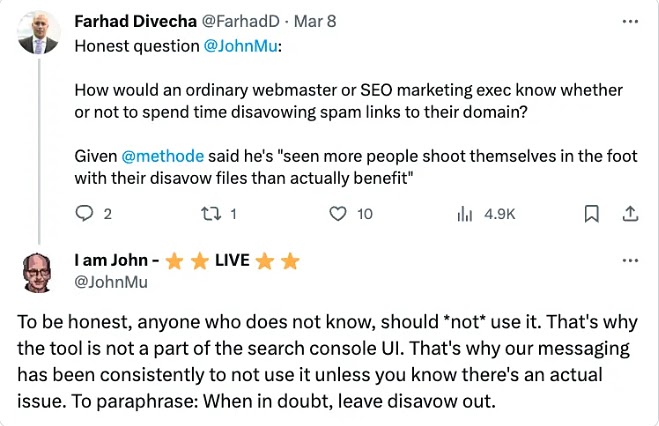
To proceed, go to the “Disavow” tab and click “Export to TXT.”
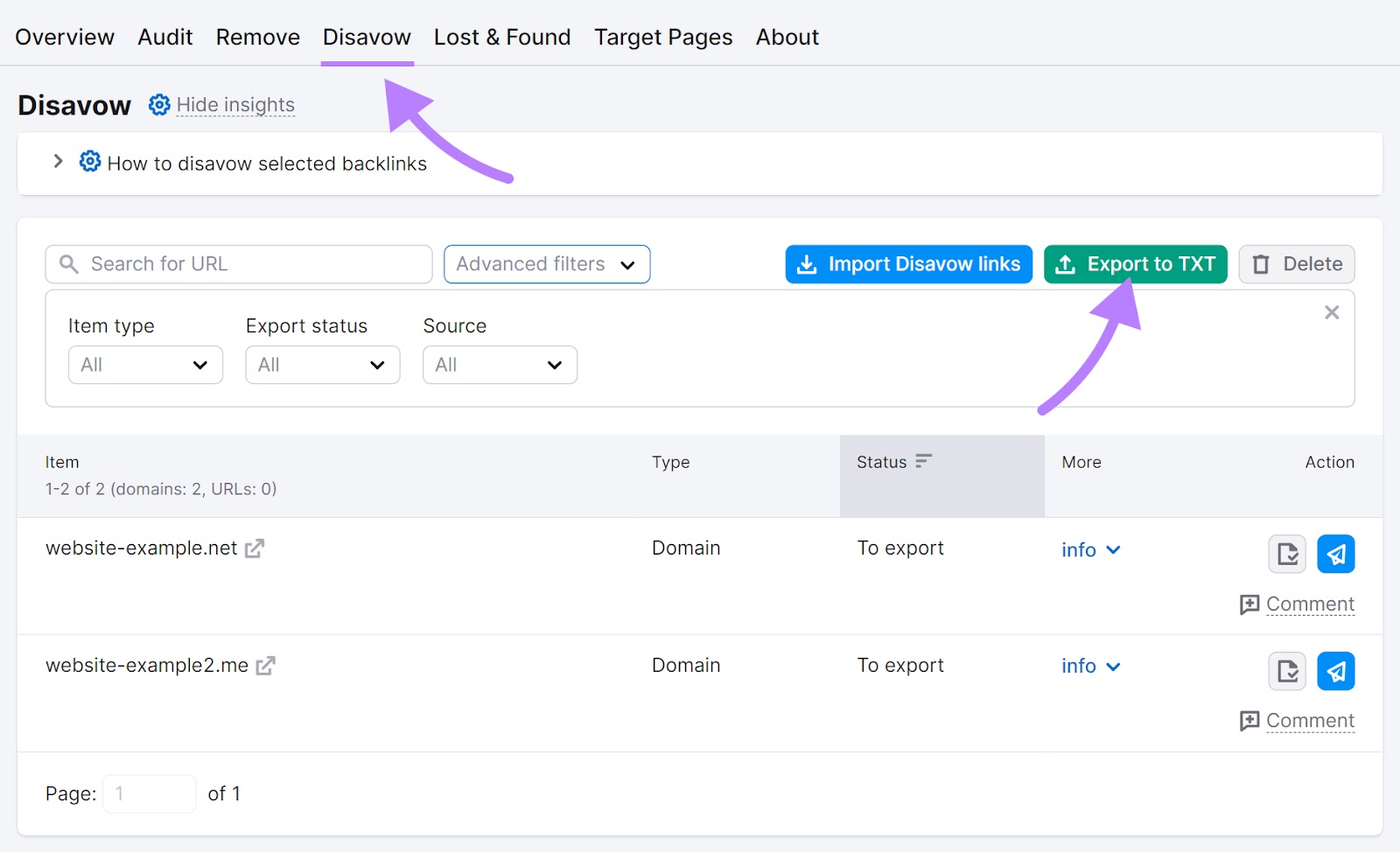
Then, upload this .txt file to Google’s link disavow tool.
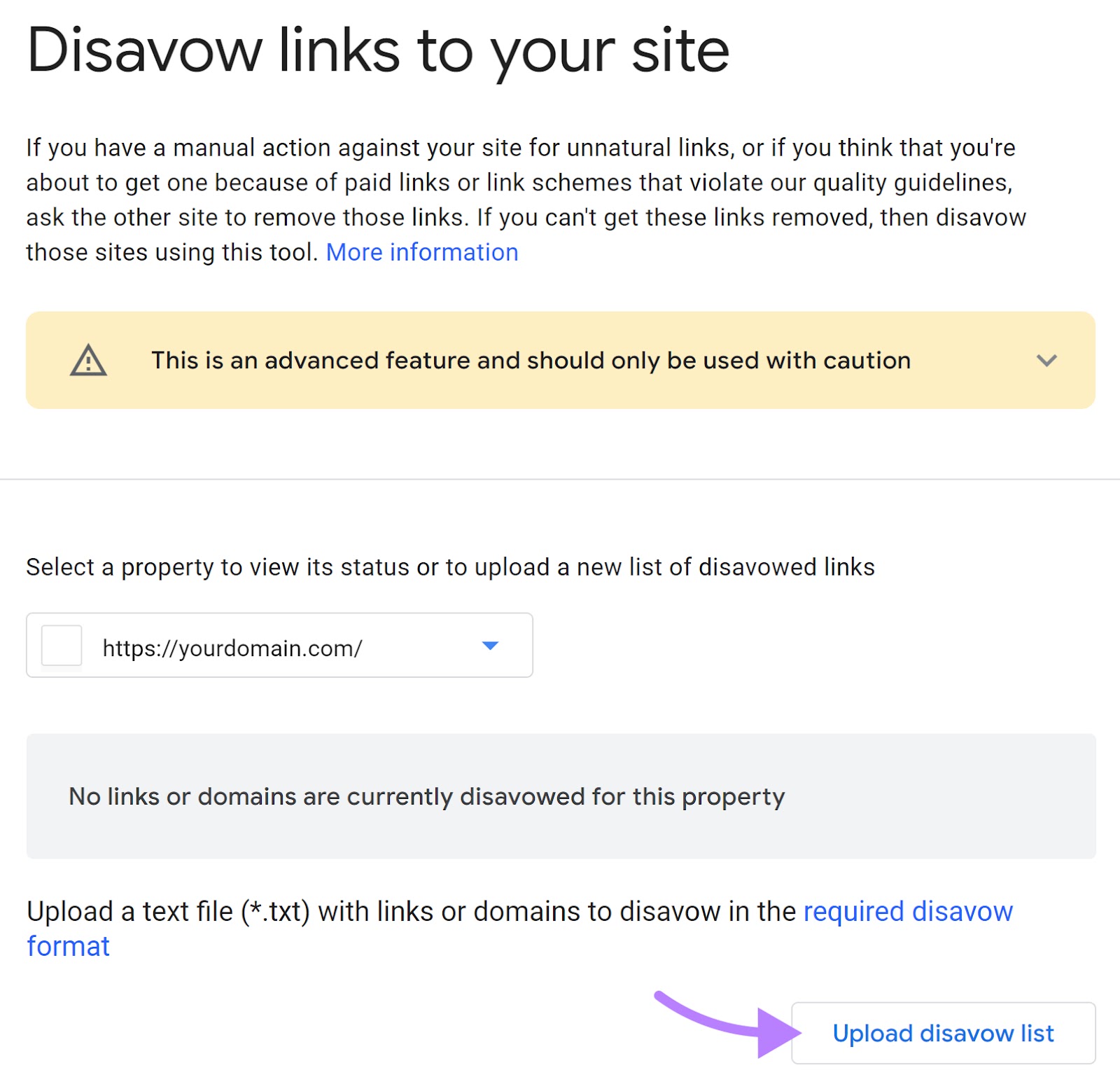
Return now to Backlink Audit and click “Yes, I uploaded the file.” Confirming you uploaded disavow links prompts the tool to recalculate your site’s TS.

If you disavowed links because of a manual action against your site, you should also request that Google reconsider the penalty. Click the "REQUEST REVIEW" button in the “Manual Actions” report:
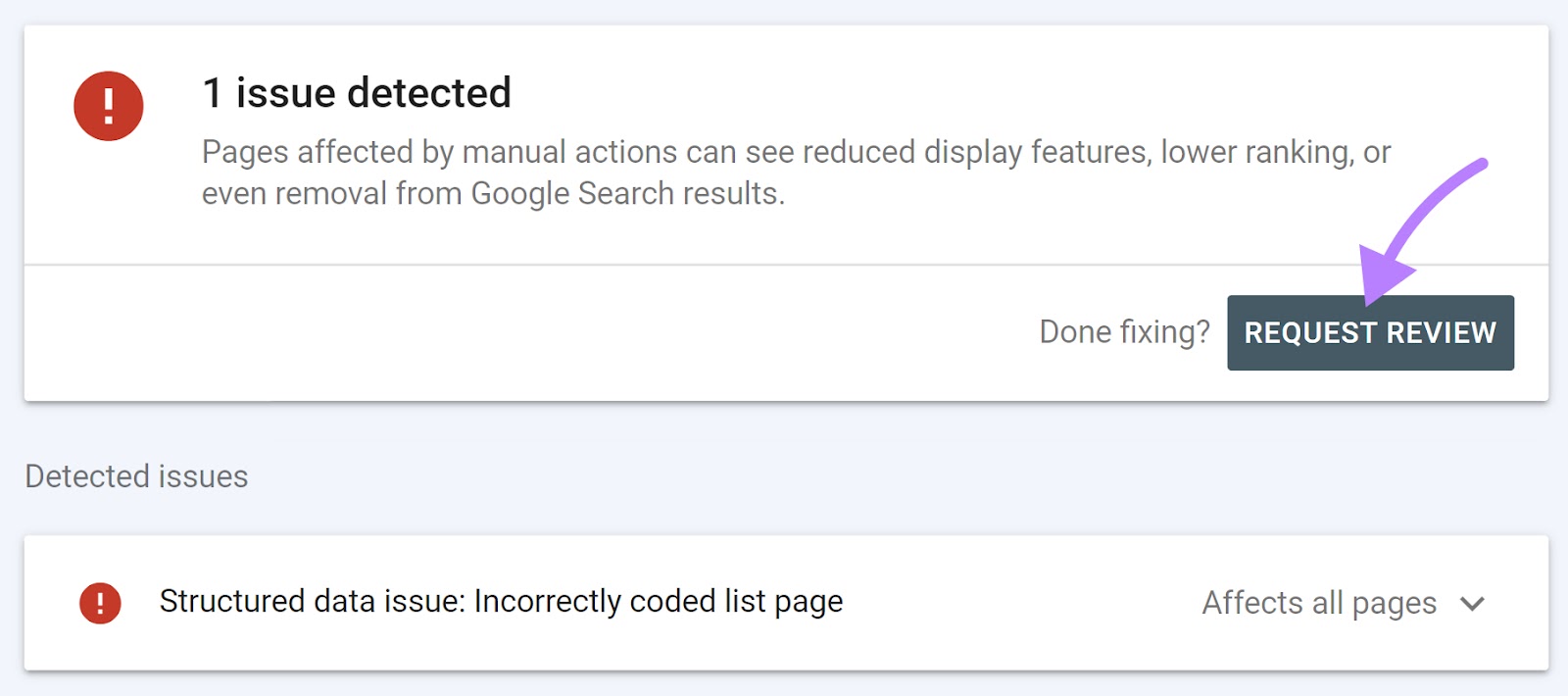
It may take several weeks for Google to process your disavow request. And for this action to have any effect on your SEO results.
How to Track Progress and Monitor Your Link Profile
Your backlink profile is likely to evolve. You’ll win new backlinks and lose some of the existing ones. The important thing is to monitor these changes and react appropriately.
The “Links” report offers a manual way of monitoring your backlink profile.
You simply review your top linked pages or top linking sites every week or month and check for any changes. And act on actionable insights.
For instance, maybe you notice your report on industry trends has lately attracted many backlinks from media sites. You can then invest even more time in promoting the report. Because it resonates well with the audience.
However, the “Links” report doesn’t offer a historical view of your backlink changes or any competitive insights. You can use Semrush’s Backlink Analytics for that purpose.
Head to the tool, enter your domain, and click “Analyze.”

You’ll now reach the main “Overview” dashboard.
Scroll down, and you’ll find data on your referring domains, backlinks, AS, and more.
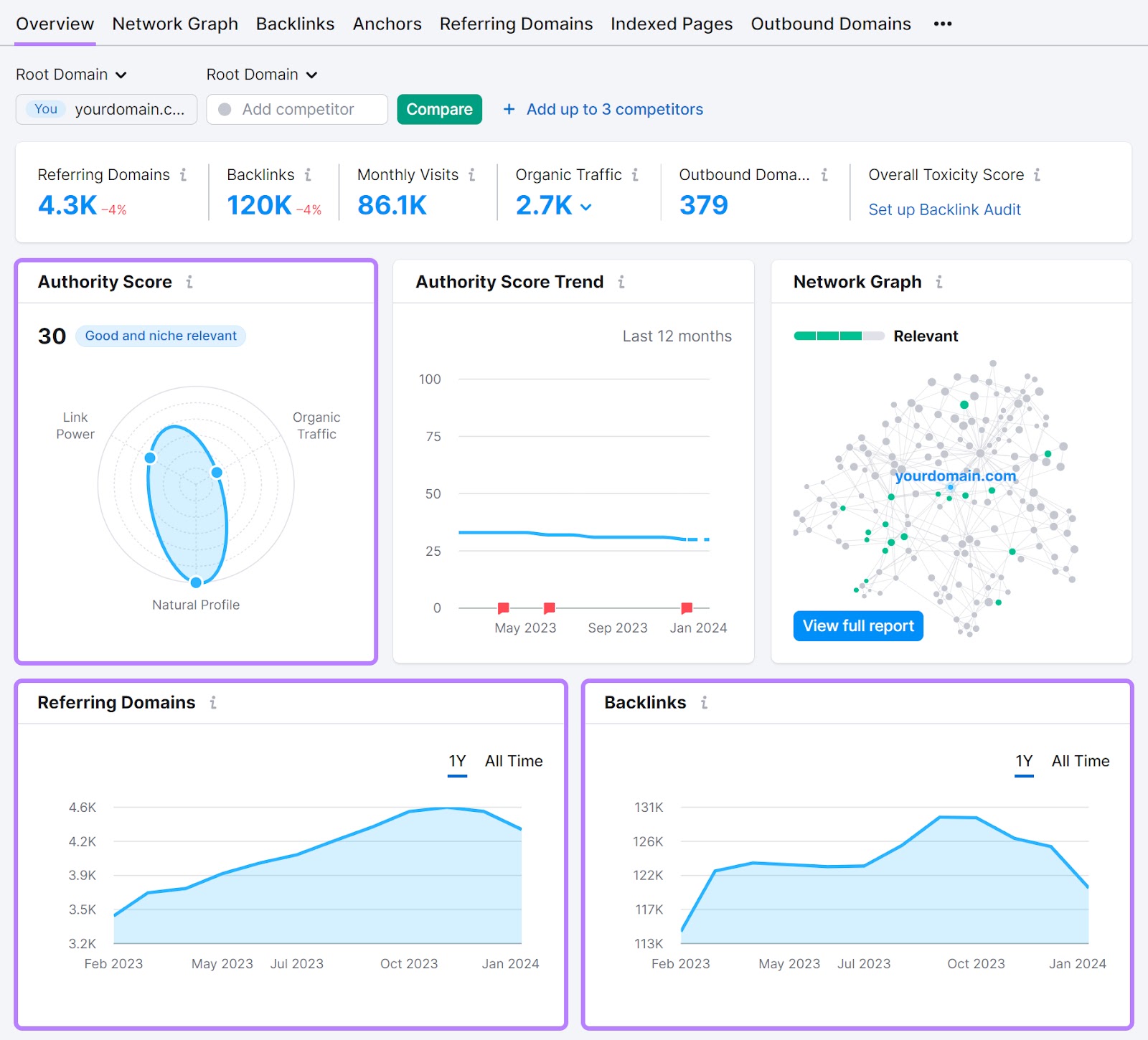
You want the number of referring domains and backlinks to be trending upward. Which should positively impact your site’s AS as well.
The AS of referring domains and link attributes are also useful data points.
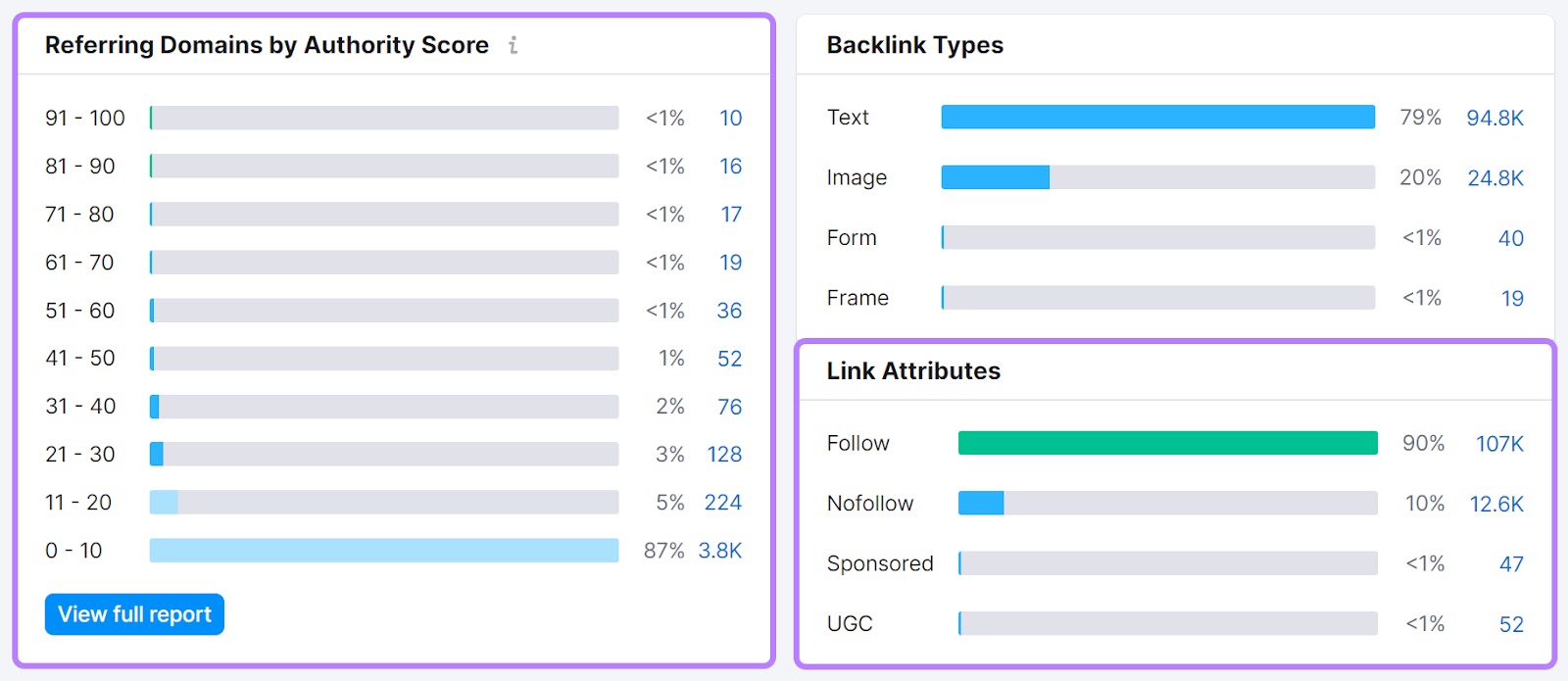
You want to have many high-authority domains linking to you.
And many of those backlinks should be "Follow" links that pass link equity. Unlike "Nofollow" links.
Another way to monitor backlink changes is to benchmark your site against your competitors'.
Simply add up to four competitors in the upper part of the “Overview” dashboard. And then click “Compare.”

You’ll now get a detailed comparison of your and competing sites.
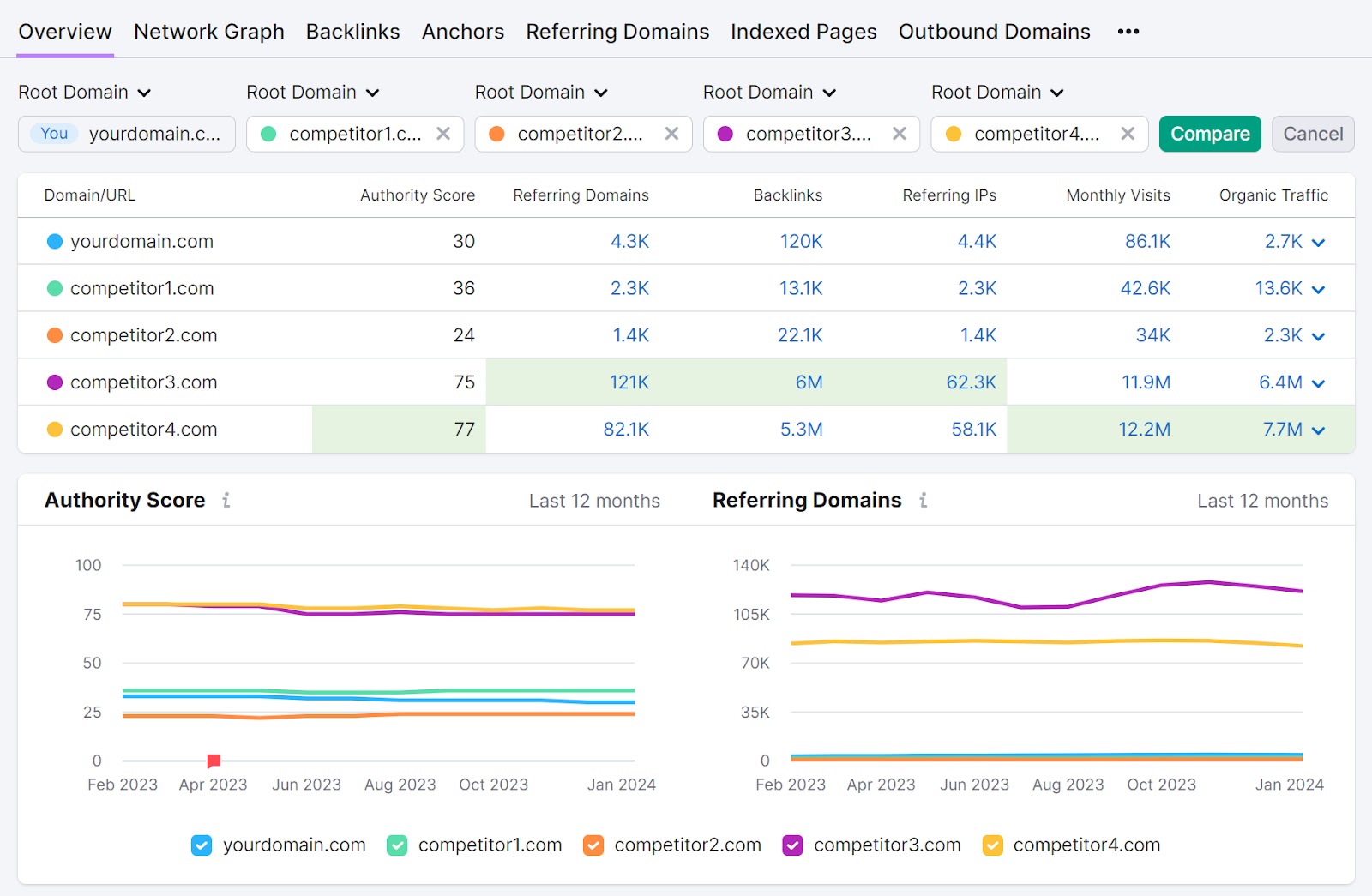
You might notice, for instance, that a particular competitor has recently acquired more backlinks than you. You might decide to investigate which of the competitor’s pages drive backlinks.
To do that, simply add that competitor’s domain to Backlink Analytics and head to the “Indexed Pages” tab.
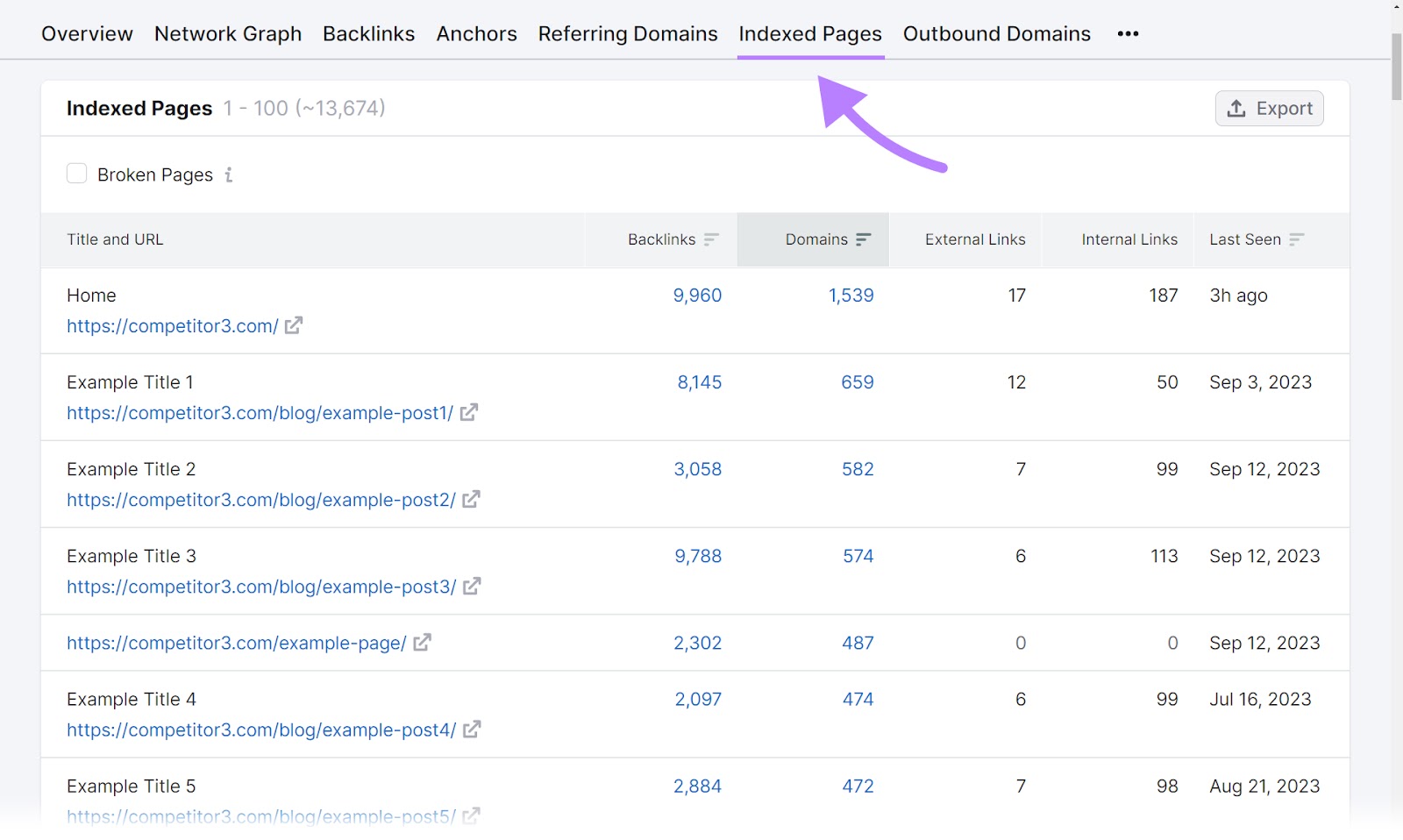
Here, you’ll find the list of the competitor’s pages that attract the most backlinks and referring domains. Study these pages to understand what makes them successful.
Did your competitor create a free tool that other sites link to? Or maybe they used proprietary data to create reports media frequently references?
You could use the same tactic. And earn links with link-worthy content assets.
Find and Seize Link-Building Opportunities
The “Links” report offers an up-to-date view of your backlink profile. And contains insights that can inform your link-building efforts.
But you might want first to understand the health of your backlink profile.
Check out our Backlink Audit tool and start your free trial today.
After that, start seizing the link-building opportunities you discover.
